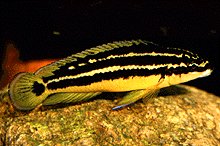 |
Julidochromis ornatus |
ORNATUS. |
means decorated or beautiful. |
COMMON NAMES |
None, but sometimes referred to as ornatus |
Endemic to Lake Tanganyika. It is found in at least four locations Mbity, Kapamba, Uvira and Kalungwe but they differ slightly in colour and I am not sure whether they would interbreed. But then nobody should try to interbreed.
J. ornatus is a shade of yellow and has black stripes on each side. The lower from the end of the snout to the base of the caudal, the upper along the base of the dorsal. A large round black spot on the base of the caudal. It also has a small black spot at the base of the pectoral.
70-80 mm.
Females tend to be larger than males when young. It is said that the males gradually catch up in the size stakes when older but I have not found this to be the case in my experience.
J. ornatus is limited to the rocky areas of Lake Tanganyika and rarely strays. It swims very close to, and with its belly towards, the nearest rock. This results in the fish frequently swimming on their sides or upside down, apparently with the same ease as the right way up.
J. ornatus spawns in caves.
It is know to uses two methods.
or.
The eggs hatch after 3-4 days and the fry are free-swimming after 7 or so days. They remain in the vicinity of the breeding site until they measure about 1" after that they gradually wander away. In the aquarium they are unable to do so effectively due to lack of space, and so are liable to be attacked by the parents when they become large enough to represent competition. Fry are exact miniatures of their parents.
T here is no apparent sexual-dichromatism but the genital papilla in the male is normally constantly visible from about 1" S.L. onwards, being small, dark, and pointed.
The best way to obtain a pair is to buy half a dozen juveniles of about 1" S.L. and allow them to pair off. This will normally result in a pair and four rescued individuals if you are in the right place at the right time. They can often be kept as a pair and family in a smallish tank, Two-foot minimum, but can also be kept successfully as part of a Tanganyikan community. This should comprise of open water dwellers or shell breeders, not cave dwellers.
Water chemistry and temperature should be as for all Tanganyikans, hard, alkaline (pH 8+), about 26oC. Given the habits of the species plenty of rockwork is required.
A mated pair will often live harmoniously together for months or even years, producing regular batches of fry, but if anything upsets them a bloody divorce is the usual result, with the larger winning. It is impossible to predict what will cause this. The usual triggers are removing fry. Some should always be left, and only a few removed at a time. The golden rule is to avoid disturbance as much as possible, and if there has been any disturbance, watch the pair like a hawk for a few days and intervene if necessary. Large water changes will also trigger this, so 10-20% per week is better than 50% per month.
They will eat anything, so a varied well balanced high protein diet is easy.